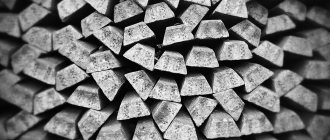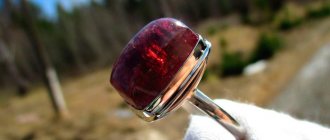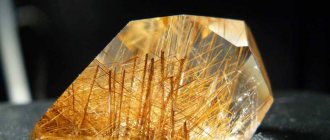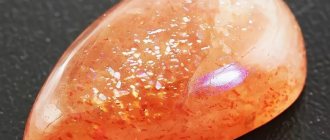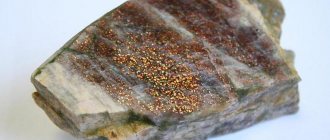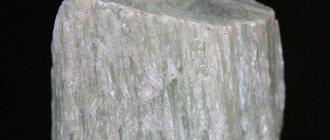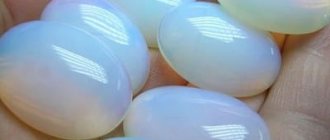Rainbow quartz and mystic topaz stones are distinguished by their unusual color and holographic shine. Spectacular and bright gems owe their characteristics to nature and human hands. But, despite the fact that the stones undergo special processing, they are based on minerals of natural origin. Their structure remains the same during exposure to chemicals, only the color scheme changes. In this article, we will consider in turn two types of mystical stone, their properties and characteristics.
Mystical topazes
Distinctive features
Topaz is an aluminum silicate containing silicon. Its chemical formula is Al2[SiO4](F,OH)2. Mystical Topaz has been produced since 1993. The author of the development is the coating production company Azotic Coating Technology Inc. For their work, specialists use colorless specimens that do not have a high value on the jewelry market. In addition, topazes grown in laboratory conditions are also used as a basis.
Mystic stones shimmer in green, blue and violet shades, have a mirror shine and holographic play of colors.
The technology for transforming a colorless stone into a multi-colored one involves applying a special composition that lies on the surface in the form of a film. The shade range of finished stones is wide: from green to purple. The coating composition for mystical topaz includes titanium and gold. The company does not disclose other details about its invention.
You can learn more about topaz from the article “Who is the topaz stone suitable for and its properties.”
Properties and characteristics
After applying the composition, the mystic stone does not change the formula, but acquires new properties. In its original form, topaz is not destroyed even under the influence of hydrochloric acid. Upon contact with the reagent, the surface of the mystic stone completely dissolves. Damage can also be mechanical in nature. In this regard, jewelry with a rainbow gem is not recommended to be worn daily.
Like regular topaz, rainbow topaz is also electrified. Its hardness is 8 Mohs units. When the stone is heated for a long time, hydrogen fluoride is released. It is a toxic gas that has a foul smell like rotten eggs. Emissions from the stone will not cause harm to health, since the volume of gas in the spray composition is minimal.
Despite the fact that quartz is unpretentious in everyday life, it is worth approaching the issue of care and storage seriously. Otherwise, the product will quickly lose its presentation. Stones need a separate place for storage. Frequent wear causes the surface to become scratched. Therefore, keep your jewelry in a box lined with velvet on the inside.
Do not wear the product to the beach, pool, or gym. Do not engage in physical labor in them, protect them from chemical compounds, including detergents.
It is not recommended to clean jewelry with mystic on your own. It is better to entrust this to a jeweler. All that can be done at home is to rinse the pebble under running water and wipe with a cloth.
Difficulty of verification
Due to the fact that mystic topaz is subjected to external processing, it is difficult to distinguish a natural stone from a cheap fake glass behind the film. The only distinguishing feature of the original is the density of the natural gem. Mystic topaz stones are characterized by a density of more than 4 g/cm³, which is one and a half to two times more than that of glass and plastic.
If the weight of the crystal is too small, it is probably not real. In front of you is plastic. Another indicator of simulation is the speed of heat absorption. A real mineral takes a long time to warm up in the palm of your hand.
In addition, mystical topaz may not be of natural origin. Today, these stones are synthesized in laboratory conditions. Aluminum oxide and silicon are used as feedstock. A jeweler can distinguish synthetic topaz from natural one by conducting a gemological examination.
This includes instrumental diagnostics, determination of chemical characteristics with subsequent prediction of the cost of the stone being examined. The origin of the mineral is determined (natural or laboratory), and it is also determined whether the stone has been artificially refined.
Magical and healing properties
If rainbow topaz is created by nature itself, its magical properties are fully manifested. The synthetic stone does not carry energy and is neutral towards its owner.
Esotericists and bioenergeticists claim that some magical abilities of the stone disappear after irradiation, while others remain and even intensify. In particular, this is due to changes in the color spectrum. Violet, blue and green shades have an influence. In addition, rainbow quartz is believed to grant wishes.
Among other abilities of the mineral:
- protection from negative external influences (evil eye, damage, curses);
- protection from illnesses and accidents;
- assistance in learning and acquiring knowledge.
Such an amulet adds natural charm, self-confidence to its owner, and enhances charisma. Among those who are suitable and favored by the talisman are travelers, truck drivers, and scientists. The amulet is suitable for children and teenagers, neutralizing the negativity that comes to them from the outside. The talisman treats nervous disorders, relieves insomnia and strengthens the immune system.
It is better to frame the stone with precious metals.
The effect of the mineral will be equally strong regardless of the type of product. The zodiac signs that astrologers recommend acquiring such talismans are Scorpio and Gemini.
Jewelry with topaz and cost
Mystic topaz in silver enhances its beneficial effects, so it can serve as a reliable amulet and talisman. Choose those that suit your taste. Topaz loves precious metals. In addition to silver, choose jewelry made of gold or platinum.
Topaz is one of the most expensive stones on the jewelry market. This is also true for mystic topaz, despite the fact that jewelers do not classify the transparent crystal as precious. The cost of such products varies widely. The price of the finished product depends on a number of factors:
- size;
- level of skill of the jeweler;
- color saturation;
- complexity of design.
Small diamond-cut inserts with a diameter of 1-2 mm cost from 1000 rubles. Earrings framed in silver will cost at least 7,000 rubles. The price of a gold ring with a mystical stone starts from 9,000 rubles.
What zodiac signs is it suitable for?
Balanced, order-loving Libra is the ideal mineral for whom any color is suitable. The value of a black opal stone will be appreciated by Scorpios, in whom it will dampen aggressiveness.
The stone is patronized by the Moon, which is why it is often called lunar. Lunar opal is a real amulet for Pisces, also under the care of the luminary. Aquarius and Gemini can use any shimmering stone as a source of inspiration.
It is better for Aries and Leo not to get involved with him because of inappropriate energy; in extreme cases, choose white or blue. Opal and the zodiac sign Sagittarius can be friends if the stone is equally fiery. Fire opal is also significant for Virgos and Capricorns. Light colored gems, especially white and blue, suit all signs.
Rainbow quartz
general characteristics
The quartz stone, reminiscent of the mystic topaz, is also of natural origin. Rainbow quartz has an iridescent iridescent sheen due to its structure. It contains bubbles of water and air, as well as numerous internal microcracks that refract light. You can learn more about quartz, as well as what its main characteristics are, from the article “The formula of quartz, its varieties and properties.”
Mystical quartz is also obtained in laboratory conditions. To do this, the base is exposed to radiation, after which its surface is coated with silver, gold and titanium. As a result, mystic quartz takes on green, blue and purple hues.
The ancient Mayans believed that rainbow quartz was a gift from the Moon Goddess. The Scandinavians believed that they paved the bridge connecting the worlds of mortals and gods. The Celts looked for treasures hidden by the leprechaun at the location of the gem.
Healing and magical properties of rainbow quartz
Ancient healers ground rainbow quartz into powder and used it for poisoning. The ancients believed that wearing a talisman with a gem protected against evil forces. Modern bioenergetics experts claim that rainbow quartz actually has this property. The mineral renews cells, rejuvenates the body, adds vitality and has a beneficial effect on a person’s overall well-being.
As for artificially colored stones, magicians believe that their influence is not so effective and tangible.
It is believed that quartz of natural origin is a powerful amulet against negative influences. It gives its owner good luck in business, enhances natural magnetism and charisma, and attracts true love.
For maximum effectiveness, the stone must be periodically recharged with energy. To do this, just place it on the windowsill and expose it to direct sunlight. If you have the opportunity to do this on the river bank, the stone will absorb the energy of several natural elements at once.
Who is it suitable for?
Rainbow quartz is the ideal companion for Cancers. The amulet will help Gemini in difficult life situations. By choosing such a talisman, Leos will stop making rash decisions. For serious and overly pedantic Virgos, the amulet will add ease to the perception of events. For everyone else who likes mystic quartz, it is recommended to wear it no more than five times a year.
Store jewelry with quartz in a box lined with velvet on the inside and keep it away from chemicals.
If the article was useful to you, share it with other users and give it a “class”.
Loading…
Healing properties
In addition to external irritants and hereditary factors, one of the main causes of diseases is movement disorders, stagnation or leakage of energy flows. The properties of the rainbow quartz stone allow you to bring the flow back to normal, which makes it possible to cope with the following problems in the body:
- pain of various origins;
- depression, apathy and depressed mood;
- non-healing wounds and scars;
- disturbances in liver function;
- diseases of the gastrointestinal tract;
- colds;
- weakened immune system;
- nervous system disorders;
- diseases of the female reproductive organs;
- deterioration of potency;
- chronic fatigue.
Another area of application for rainbow quartz is dermatology. In folk medicine, so-called quartz water is used to treat skin problems. To prepare it, you need to drop a pebble into the purified liquid and let it stand for several hours. The result is something like a healing tonic that effectively eliminates rashes.
Signs of a natural mineral
True blue topaz is characterized by a number of characteristics:
- A genuine stone will be smooth to the touch; processed crystals will have a smooth and silky surface, which is not the case with ordinary glass.
- If you rub the mineral on wool, it will become highly electrified and will attract dust particles, threads, and pieces of paper.
- An assessment of the crystal structure will help determine the authenticity of topaz. It should show inclusions and irregularities. Ideally transparent stones with an even, rich color are also found in nature, but are extremely rare, so they are expensive. It is better to refuse to buy such an impeccable copy at an average price.
- The natural mineral has a low shine.
- Natural stone is a poor conductor of heat, so it heats up slowly and its surface is cool.
- If you run a real gemstone over crystal, glass or quartz, the stone will leave a scratch on it. This experiment must be carried out carefully so as not to damage the product.
- Changes color slightly depending on lighting.
These tips are designed to help you determine the authenticity yourself at home, but only a jeweler will surely know how to distinguish a natural gem from a fake.
When purchasing, do not neglect the advice of a specialist. An obvious sign of a fake is a low price.
Sometimes blue crystals themselves can be an imitation of more expensive stones. They are sold as sapphires and aquamarines. In the first case, hardness is assessed (for topaz it is less than for sapphire), the refractive index of light and specific gravity. You can distinguish a stone from aquamarine by its stronger shine and play of colors. In addition, aquamarine has a silvery sheen that topaz does not have.
Types of fakes
Imitation of precious stones is a lucrative form of fraud that has been known since ancient times. Previously, colored non-precious crystals were often passed off as blue topazes. Today's counterfeiting technology has advanced, jewelry is often counterfeited, but there are still ways to tell the difference.
- Often colored glass is passed off as a precious gem, but it is easy to distinguish them due to their physical properties and appearance. The law obliges the seller to inform the buyer that this is not a natural stone, but a glass imitation.
- Topaz and rauchtopaz should not be confused. Sometimes scammers, hiding behind the name, pass it off as a type of precious mineral, but in fact, rauchtopaz is smoky quartz. It received this name back in ancient times (“rauch” is translated from German as “smoke”), and it stuck. This grayish-brown stone is noteworthy and can look great in jewelry, but its price is less than that of topaz.
- An insidious fake is the artificial mineral cubic zirconia. Both in appearance and in physical properties, it is very similar to topaz; it can have a yellow, orange or blue color; it can only be distinguished by analyzing the crystal lattice.
- Treated topazes. Blue or dark blue crystals are rarely found in nature and cost between $100-120 per carat. Jewelers have learned to give colorless or lightly colored specimens the desired color. The mineral is subjected to heat treatment or irradiation. The result is stones of a rich blue hue. Such gems are, in fact, natural. The method of obtaining the color is indicated by the words “heated” or refined” in the name of a particular sample.
- Synthetic crystals. They are grown using hydrothermal technology, recreating in the laboratory the conditions in which topaz “grows” in nature.
Labrador deposits
The largest deposits were discovered in the last century on the territory of modern Ukraine - Guta Dobrynskaya, Golovinskoye, Siny Kamen, Rudnya-Ocheretyanka. Mining is still underway in eastern Canada - the Labrador Peninsula and the Greenville Mines. Single small deposits have been discovered in Finland, India, Greenland, and Tibet.
Rare gem-quality minerals are mined in Australia. Spectrolites, a type of labradorite, are found in only one place on Earth: the vicinity of the Finnish city of Ylämaa.
How to identify synthetic stone
Artificial crystals are obtained in laboratory conditions; this is a labor-intensive and expensive process. Such minerals cost less, and often look better - more transparent, with a rich color. Topazes with impurities are not considered fakes - sometimes they are added specifically during processing to give the stone the desired color.
The production of hydrothermal topaz is not economically profitable, so artificial sapphire or ruby is often used as an imitation. Analogues are similar to a real gem in appearance and repeat most of the physical properties. But synthetic stone is usually less strong and durable. Its synthesis is similar to growing flowers in a greenhouse. Scientists create the conditions necessary for a mineral to develop, monitor its growth, and purposefully influence its external qualities - color, transparency, shine. The crystals grown under such conditions are larger than in nature, their growth rate is several times faster, and the colors are more saturated: natural bright blue topaz is difficult to find in nature.
Growing stones in artificial conditions is regulated by legal acts, according to which the jewelry tag must indicate that the mineral is synthetic. If there is no information about the origin of the insert, it will not be easy to recognize synthetic topaz at home.
Its main difference from natural is the depth of shade and the complete absence of defects.
It is necessary to distinguish synthetic topaz from cubic zirconia, which has no analogue in nature and is therefore cheaper. This artificial crystal has a strong, diamond-like luster, which is not characteristic of topaz. In addition, cubic zirconia does not have the effect of pleochroism - it does not change color when the viewing angle or lighting changes.
History and origin
- In the mythology of Ancient Greece, the gem is associated with the thunderer Zeus, who, having defeated the Titans, burst into tears of happiness. Every tear turned into a rainbow opal.
- In Australia they believe that these are traces of the Creator of the World himself. India sees in these stones parts of the body of the goddess of love, who was fleeing from her pursuers.
- The black mineral was Caligula's favorite stone. It is believed that it was friendship with him that ultimately destroyed the bloody Roman emperor.
- Obtained by illegitimate means, the stone took revenge on several European royal dynasties.
How to recognize a fake quartz or glass
Quartz and glass fakes are common because they are cheaper and at first glance indistinguishable from natural stone. But there are some features that allow you to distinguish topaz from a fake:
- Glass and quartz are much rougher and more transparent, while a real gem has smooth edges and tiny inclusions or defects in the structure.
- Expensive stones are combined with gold and platinum, less often with silver, but topaz in a silver frame is a common occurrence on the jewelry market. A seller who claims that he is offering a real precious gem in a base metal frame is probably lying.
- You can recognize glass by its too rich and deep shade.
- Glass and other cheap imitations are always warmer and heat up faster in your hands because they transmit heat better.
- Topaz has a higher density than quartz, so if you have a quartz crystal of the same size on hand, the topaz will be heavier when comparing weight.
- The bright shine gives it away as a fake.
- Quartz and glass are not electrified, so to check, you can rub the product with a woolen cloth. If it does not attract lint, the stone is fake.
Conscientious jewelers use minerals in their products that have been authenticated by a professional appraiser. Such stones have a certificate, which the seller must provide upon the buyer's request. This is a legal document that describes the characteristics: color, size, presence of inclusions and impurities, place of extraction, cutting method. If the store refuses to provide it, it is likely that the certificate is simply missing, which indirectly indicates the sale of an imitation.
What names is it suitable for?
Jewelry of any color helps mainly women. These are Olga, Inna, Tamara, Bronislava, Anna, Anastasia. The fire gem will also suit Angela, bringing her hope and happiness. Olesya will help in any endeavor and bring peace.
Also, the stone is ideal for a representative of the stronger half with the name Anatoly. Anton will be given success in love affairs and will encourage him to achieve high goals. Vitaly will be helped in self-knowledge and improvement, as well as cope with excessive self-confidence and stubbornness.
So, opal is a precious or semi-precious stone, known for its opalescence effect, that is, the play of colors and shades. Very fragile, contains water, the amount of which may vary. A lack of it can cause it to dry out and even crumble.
Loved by jewelers and collectors. Earrings, rings, and bracelets are made from it. Purple opal is one of the rarest. The opal cabochon looks very beautiful.
